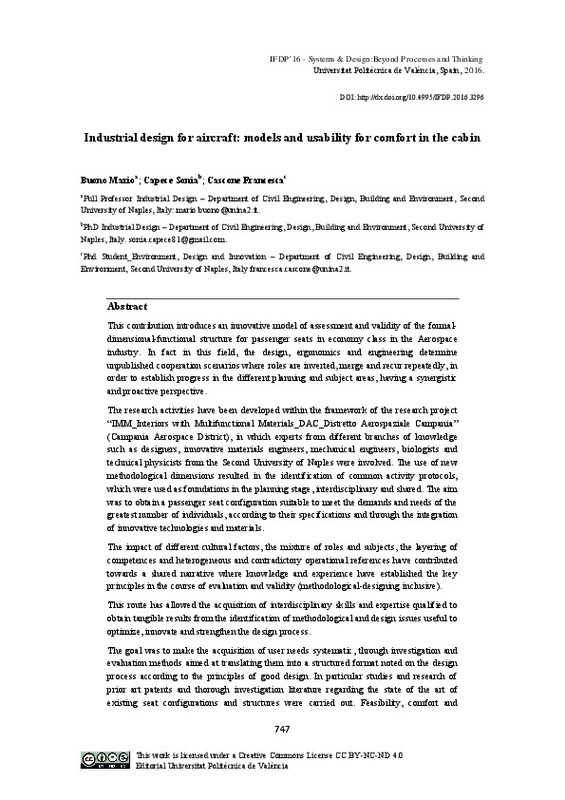|
Resumen:
|
[EN] This contribution introduces an innovative model of assessment and validity of the formaldimensional-functional
structure for passenger seats in economy class in the Aerospace
industry. In fact in this field, the ...[+]
[EN] This contribution introduces an innovative model of assessment and validity of the formaldimensional-functional
structure for passenger seats in economy class in the Aerospace
industry. In fact in this field, the design, ergonomics and engineering determine
unpublished cooperation scenarios where roles are inverted, merge and recur repeatedly, in
order to establish progress in the different planning and subject areas, having a synergistic
and proactive perspective.
The research activities have been developed within the framework of the research project
“IMM_Interiors with Multifunctional Materials_DAC_Distretto Aerospaziale Campania”
(Campania Aerospace District), in which experts from different branches of knowledge
such as designers, innovative materials engineers, mechanical engineers, biologists and
technical physicists from the Second University of Naples were involved. The use of new
methodological dimensions resulted in the identification of common activity protocols,
which were used as foundations in the planning stage, interdisciplinary and shared. The aim
was to obtain a passenger seat configuration suitable to meet the demands and needs of the
greatest number of individuals, according to their specifications and through the integration
of innovative technologies and materials.
The impact of different cultural factors, the mixture of roles and subjects, the layering of
competences and heterogeneous and contradictory operational references have contributed
towards a shared narrative where knowledge and experience have established the key
principles in the course of evaluation and validity (methodological-designing inclusive).
This route has allowed the acquisition of interdisciplinary skills and expertise qualified to
obtain tangible results from the identification of methodological and design issues useful to
optimize, innovate and strengthen the design process.
The goal was to make the acquisition of user needs systematic, through investigation and
evaluation methods aimed at translating them into a structured format noted on the design
process according to the principles of good design. In particular studies and research of
prior art patents and thorough investigation literature regarding the state of the art of
existing seat configurations and structures were carried out. Feasibility, comfort and reliability of the existing solutions in order to analyse and evaluate each component of
ergonomics, human factors (physical ergonomics), user centred design and new human
factors (pleasantness of use), where characteristics and specific meanings of quality,
understood as a user-seat interaction quality are preferred.
[-]
|








